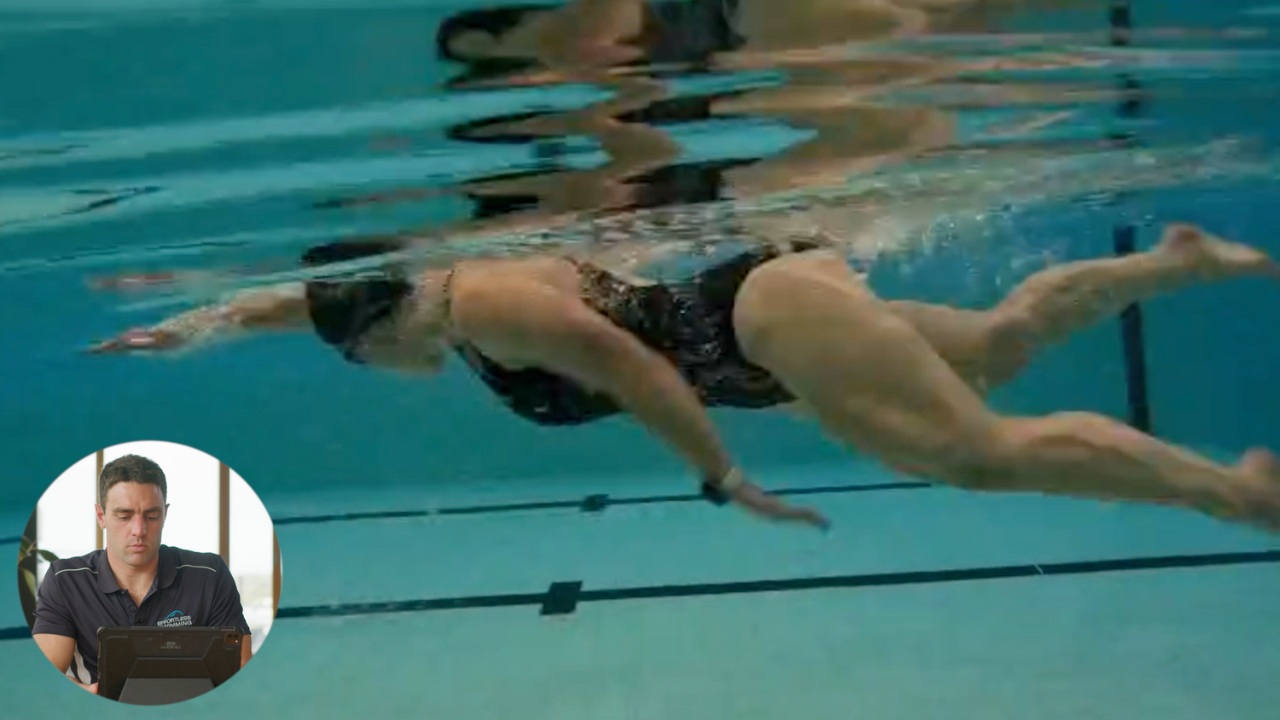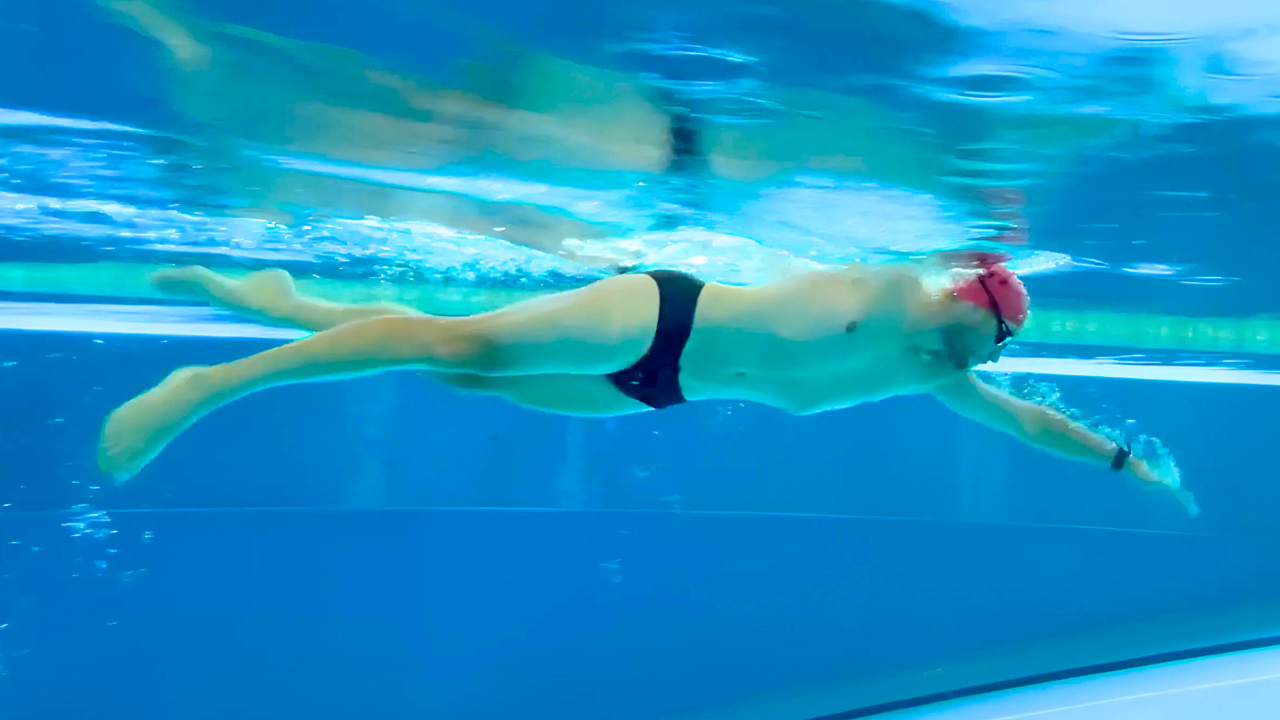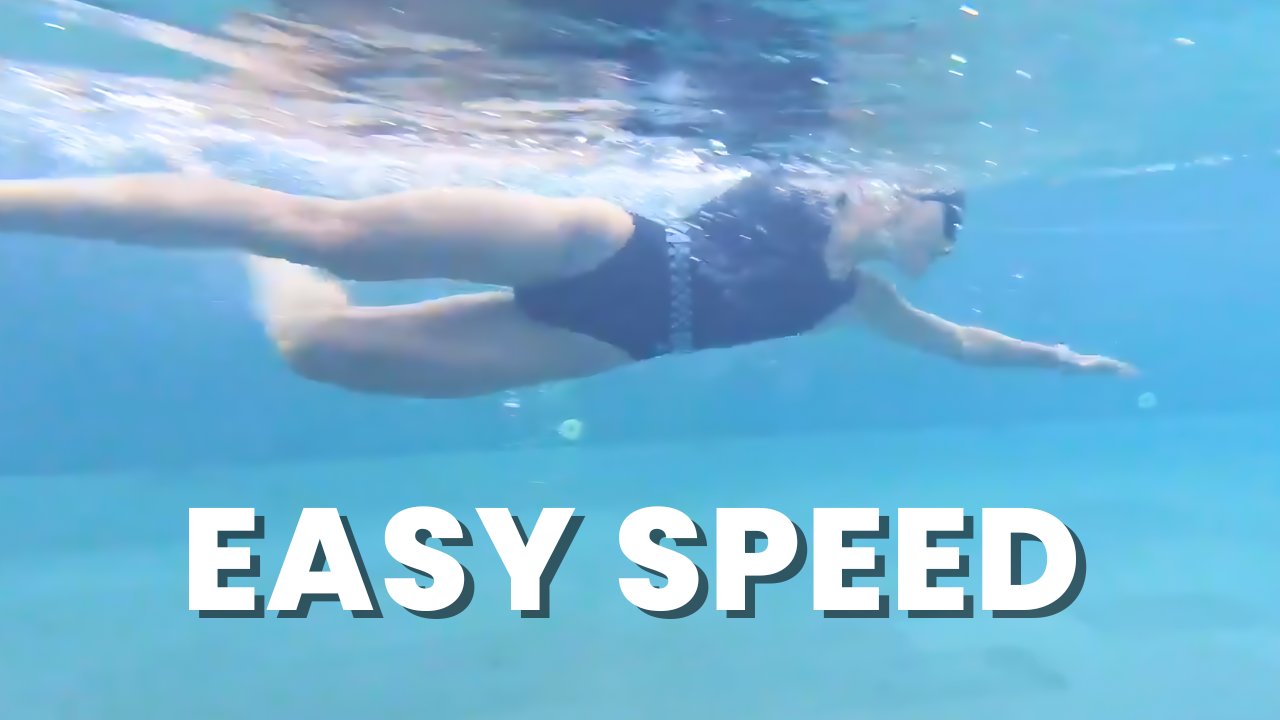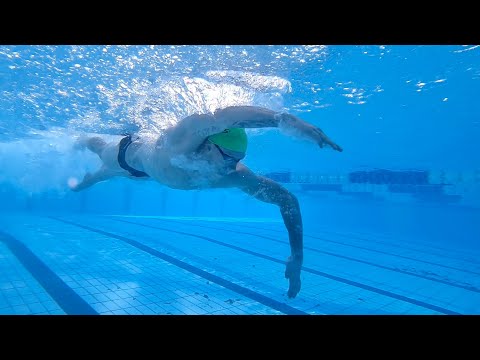Can increasing your stroke rate actually make your swimming easier? In some cases, yes. If your rating is too slow, you can lose momentum and balance in the water. We’ll look at this in today’s Feedback Friday.
Transcription:
We want to try and keep the fingertips pointing to the bottom of the pool or pretty close to it. That really just allows the hand and the forearm to work better as one big paddle as you’re moving through.
Welcome to Feedback Friday. In today’s episode, we’re looking at someone swimming from above the water from the side, and if you’ve ever gone to the pool and you’ve looked at other people swimming and you’ve thought, “I know what they can do to swim faster”, then you’ve probably seen someone swimming quite similar to this. So today we’re going to look at, all right, what could this person do, just based on our observation from above at this angle? What could they do to get quicker?
Now you will see that the body position looks quite good. We’ve got the head, hips, and heels at the surface. So he doesn’t need to really change much with that. You will notice those through his body, it’s not as straight as it could be in terms of his head, his body, and his legs. There’s a bit of curve, maybe a bit too much curve through the lower back and through the hips. And so what that indicates to us is we’d probably want to straighten that out a little bit, because it’s going to be a bit less drag if we can hold a slightly straighter position through here, and he’s going to have better connection through the body if we can get rid of that extra arch through the lower back, and that extra bend through the hips and through the waist there, because we want to try and keep that a little bit straighter to do all of those things.
So one of the things that can really cause the arch in the lower back and that bend through the body to happen is the head position. And if someone’s looking too far forwards then that’s really one of the key things. And you can see it really standing out here. Where his vision is is almost directly out in front, and when you’ve got this big kink through your neck there, it’s very hard to keep that lower back straight and to have the ideal, the best sort of connection through the core, and connection with the rest of the stroke.
So the first thing we’d probably want to do here is just to adjust the head position because you can see he’s breathing very comfortably there. He doesn’t look like he’s running out of breath, he’s getting that breath low, bottom goggles’ in the water. All of that looks really good. So with his head position, what should we aim for? You know that we typically like to aim for zero to 45 degrees. And depending on what this human is training for, look, he might want to aim for somewhere out in front there. As long as he’s keeping the back of his neck extended and long.
You see it all the time when we do Feedback Fridays, you see it that we want to get that position right, but when you get the head position and the posture right, everything else comes so much easier. And that’s why we start with that and we start with that at the clinics that we do around Australia as well. So that would be the first thing, and that should get rid of that big kink in the neck, and it should start to straighten that out. You don’t really need a drill to fix that. You can certainly use drills, but more times than not, it’s just a matter of changing where you’re looking, thinking about it, keeping it in the back of your mind, and just feeling like you’re really being lengthened through the back of the neck there. So that would be the first thing.
After that, you can see what’s happening out in front of the hand entry. All right, he’s coming through quite nicely here. This is a good recovery, the hand is relaxed, elbows pointing to the sky. As a coach, we should be able to see the underarm as he’s coming through, and which we can see there. So that just means he’s getting the shoulder out of the water enough. He’s rotating enough to come over comfortably there. So that looks really good coming through really well, and then as he goes to enter, the fingertips are entering first, which is great, then as he reaches and extends forwards, quite a good position to start the catch in there. So have a look at the left one. Same thing, pretty good recovery coming through. Fingers do enter first, which is great. On that left hand side, we do get a little bit of a rise with the fingers there, but it’s not coming up a whole lot. Although you can see as we go through here. Look the hands are probably just drifting into the center a little bit. We’re getting a little bit of a crossover there. But I mean that position is still pretty good. So look, he might be able to go a little bit deeper, just to make sure that the fingertips are the deepest part of the arm there, and he might need to go a bit wider if he’s crossing in.
Looks like he might be slightly and look, he could be a bit more forceful with the entry. It wouldn’t need to be much though, but it is good to have an assertive entry and sometimes it looks like that left hand is coming in just a little bit, a little bit gentle, a little bit soft there so he’ll get better transfer of this momentum coming over the top with the arm, get that hand in the water reaching forwards underneath the surface there. You can then just keep the momentum going a little bit better. It’s not a major thing. It’s not going to take 10 seconds off his a hundred pace at all, but it can certainly just help that, that little bit.
After that, we’ll have a look at the catch in the pool just from what we can see here. And sometimes it can be easy to look at how effective someone’s catch is from above, but other times it can be difficult just depending on the swimmer, but it looks like from here to here. All right. That’s setting up pretty nicely. You’ll see that the fingertips are pointing down. It’s a good chance he’s in a high elbow position, and it does look like he holds quite good water. From there, the hand does come into the center a bit too much, so actually see how much that in swipe is happening early on, and the fingertips are pointing to the side of the pool. We want to try and keep the fingertips pointing to the bottom of the pool or pretty close to it. That really just allows the hand and the forearm to work better as one big paddle as you’re moving through. It’s okay for them to sort of point inwards a little bit, but not too much.
So from there to there, there’s too much of an in sweep early on, and so he’s probably just slipping through this middle section from there through to there. And you’ll actually see, we’ve got this out sweep, in sweep, and then a big sort of out sweep there. So there’s just a bit too much side to side movement. What I’ll be aiming to do here is through this section, keep that hand and forearm working together. Try and avoid the in sweep happening too early. I only want it to happen once we get to about here. So those fingertips should still be pointing down. Now when he changes that, look, it’ll probably feel like he’s out quite wide with the hand, and he will feel more pressure on the hand and forearm through there. And in terms of changing it, you can do like a single arm freestyle drill. You could do the YMCA drills that we often recommend.
If we look at the left arm, seems to be following a pretty similar path. So it’s probably just… Yeah, it might be coming in towards the center a bit too much on that left hand side. You can see it in the stroke too. It looks like the setup through there. So from there to there, moving through quite nicely, and then in that middle section, he doesn’t hit a dead spot, but you can see it’s not quite as effective. So sometimes just by watching how someone is moving through the water, you can see where in the stroke they might be slipping or they might not be holding as good a water, and you can kind of see it through here as well. So that’d be a big thing to work on. That’s probably one of the big rocks that we look to change there.
The rest of it, I mean it’s looking pretty good. That kicks being kept quite narrow, and when he changes that posture, he’ll probably keep that kick even a little bit tighter, a little bit narrower, but in general it’s just really going to come down to the head position change, and working on a better catch and better pull through, and getting into that power diamond. If you’ve seen any of your videos on the power diamond, that’s that position where you’re coming under the body, and right here we want to have the arm at an angle of 100 to 120. So the angle at the elbow, and the shoulder, elbow, and hand aligned if we’re looking side on. So he could really get a lot better use of his lats through the stroke there, and just hold a lot more water by getting rid of that in sweep, that’s where we’d focus. So I’d keep it really simple and just focus on those couple of things.
If you’re looking for how do you work on your catching and your pull, we’ve got a whole bunch of other videos on this channel that you can find, or if you have a look at core principle number four, which is developing an effective catch and pull. Inside the video membership that we’ve got. There’ll be a link below. We’ve basically got a drill progression that you can go through, and a really good video, six-minute video explaining exactly what we want to achieve in the catch and the pull, and then how you can go about developing it and what you can expect to go through, and feel as you’re making those changes and improving it because it takes time, and with the swimmers that we’ve worked with, it can take anywhere from, some swimmers pick it up pretty quickly. But for most swimmers without a swimming background, yeah, it will take you typically six to eight weeks to really start to get a better feel for the water, and then you’re always just constantly improving it. But for most people that is that 80/20. It’s that 20% of the stroke where you can get 80% of the improvement just by working on a better catch and better pull, and I think for this swimmer, that’s where we’d find that increase in speed.
And it depends on what speed is this person going? Is he going at race pace, and what kind of distance is he doing? So we might look at stroke rate as well, but if you follow those five core principles that we’ve got on our website and in the video membership with all of the drills and the progressions, that’s a good way to know exactly what to work on, because if you go through those and you analyze his stroke, that’s pretty much what I’ve gone through here.
So thanks very much for watching. I’ll show a comparison video here of someone swimming from the side, and we’ll look at each of those things, the head position, have a look at what the arms are doing through the catch, and just see if you can notice a difference in position.









